Fei Ji
South China University of Technology, Guangzhou, China
Message-Passing Receiver for OCDM over Multi-Lag Multi-Doppler Channels
Jan 09, 2024Abstract:As a new candidate waveform for the next generation wireless communications, orthogonal chirp division multiplexing (OCDM) has attracted growing attention for its ability to achieve full diversity in uncoded transmission, and its robustness to narrow-band interference or impulsive noise. Under high mobility channels with multiple lags and multiple Doppler-shifts (MLMD), the signal suffers doubly selective (DS) fadings in time and frequency domain, and data symbols modulated on orthogonal chirps are interfered by each other. To address the problem of symbol detection of OCDM over MLMD channel, under the assumption that path attenuation factors, delays, and Doppler shifts of the channel are available, we first derive the closed-form channel matrix in Fresnel domain, and then propose a low-complexity method to approximate it as a sparse matrix. Based on the approximated Fresnel-domain channel, we propose a message passing (MP) based detector to estimate the transmit symbols iteratively. Finally, under two MLMD channels (an underspread channel for terrestrial vehicular communication, and an overspread channel for narrow-band underwater acoustic communications), Monte Carlo simulation results and analysis are provided to validate its advantages as a promising detector for OCDM.
Time and Frequency Offset Estimation and Intercarrier Interference Cancellation for AFDM Systems
Oct 19, 2023

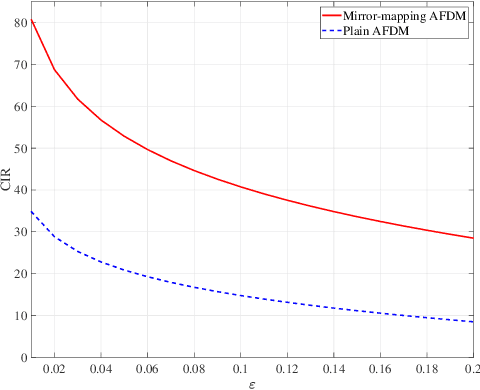
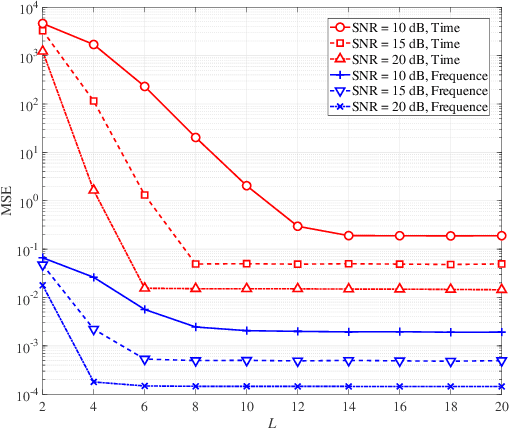
Abstract:Affine frequency division multiplexing (AFDM) is an emerging multicarrier waveform that offers a potential solution for achieving reliable communication for time-varying channels. This paper proposes two maximum likelihood (ML) estimators of symbol time offset and carrier frequency offset for AFDM systems. The joint ML estimator evaluates the arrival time and frequency offset by comparing the correlations of samples. Moreover, we propose the stepwise ML estimator to reduce the complexity. The proposed estimators exploit the redundant information contained within the chirp-periodic prefix inherent in AFDM symbols, thus dispensing with any additional pilots. To further mitigate the intercarrier interference resulting from the residual frequency offset, we design a mirror-mappingbased scheme for AFDM systems. Numerical results verify the effectiveness of the proposed time and frequency offset estimation criteria and the mirror-mapping-based modulation for AFDM systems.
Block-Wise Index Modulation and Receiver Design for High-Mobility OTFS Communications
Jun 21, 2023



Abstract:As a promising technique for high-mobility wireless communications, orthogonal time frequency space (OTFS) has been proved to enjoy excellent advantages with respect to traditional orthogonal frequency division multiplexing (OFDM). Although multiple studies have considered index modulation (IM) based OTFS (IM-OTFS) schemes to further improve system performance, a challenging and open problem is the development of effective IM schemes and efficient receivers for practical OTFS systems that must operate in the presence of channel delays and Doppler shifts. In this paper, we propose two novel block-wise IM schemes for OTFS systems, named delay-IM with OTFS (DeIM-OTFS) and Doppler-IM with OTFS (DoIM-OTFS), where a block of delay/Doppler resource bins are activated simultaneously. Based on a maximum likelihood (ML) detector, we analyze upper bounds on the average bit error rates for the proposed DeIM-OTFS and DoIM-OTFS schemes, and verify their performance advantages over the existing IM-OTFS systems. We also develop a multi-layer joint symbol and activation pattern detection (MLJSAPD) algorithm and a customized message passing detection (CMPD) algorithm for our proposed DeIMOTFS and DoIM-OTFS systems with low complexity. Simulation results demonstrate that our proposed MLJSAPD and CMPD algorithms can achieve desired performance with robustness to the imperfect channel state information (CSI).
A Novel Block-Wise Index Modulation Scheme for High-Mobility OTFS Communications
Oct 25, 2022Abstract:As a promising technique for high-mobility wireless communications, orthogonal time frequency space (OTFS) has been proved to enjoy excellent advantages with respect to traditional orthogonal frequency division multiplexing (OFDM). However, a challenging problem is to design efficient systems to further improve the performance. In this paper, we propose a novel block-wise index modulation (IM) scheme for OTFS systems, named Doppler-IM with OTFS (DoIM-OTFS), where a block of Doppler resource bins are activated simultaneously. For practical implementation, we develop a low complexity customized message passing (CMP) algorithm for our proposed DoIM-OTFS scheme. Simulation results demonstrate our proposed DoIM-OTFS system outperforms traditional OTFS system without IM. The proposed CMP algorithm can achieve desired performance and robustness to the imperfect channel state information (CSI).
Low Complexity First: Duration-Centric ISI Mitigation in Molecular Communication via Diffusion
Jul 19, 2022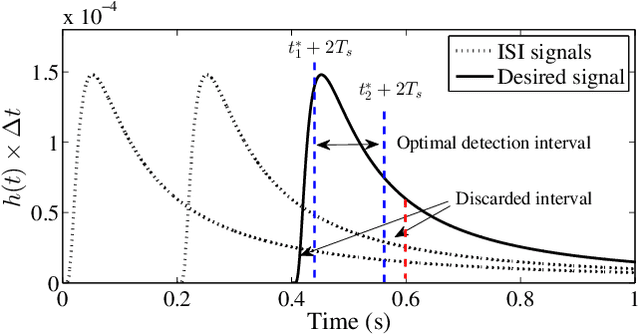
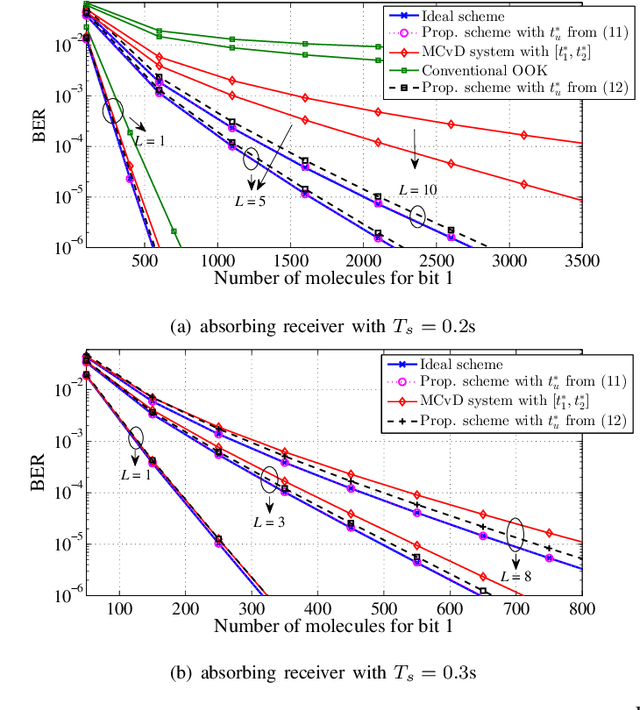
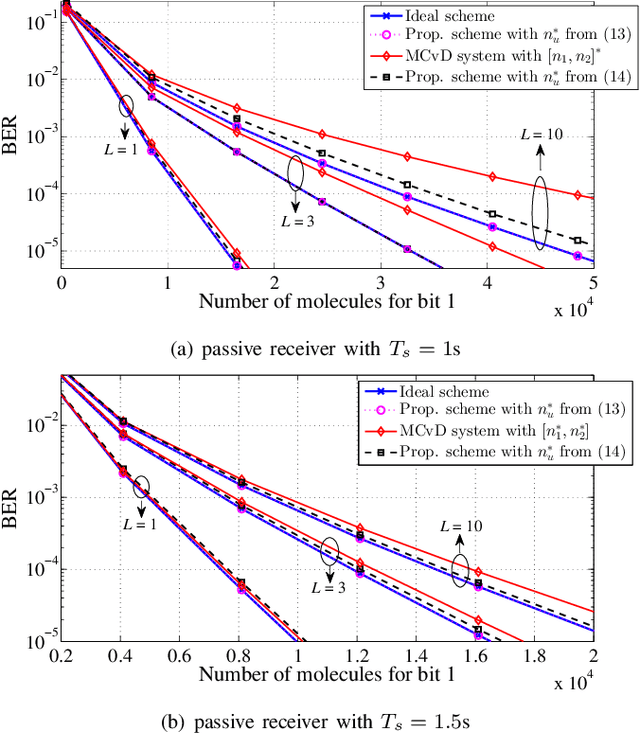

Abstract:In this paper, we propose a novel inter-symbol interference (ISI) mitigation scheme for molecular communication via diffusion (MCvD) systems with the optimal detection interval. Its rationale is to exploit the discarded duration (i.e., the symbol duration outside this optimal interval) to relieve ISI in the target system. Following this idea, we formulate an objective function to quantify the impact of the discarded time on bit error rate (BER) performance. Besides, an optimally reusable interval within the discarded duration is derived in closed form, which applies to both the absorbing and passive receivers. Finally, numerical results validate our analysis and show that for the considered MCvD system, significant BER improvements can be achieved by using the derived reusable duration.
Model-Driven Based Deep Unfolding Equalizer for Underwater Acoustic OFDM Communications
Jul 10, 2022

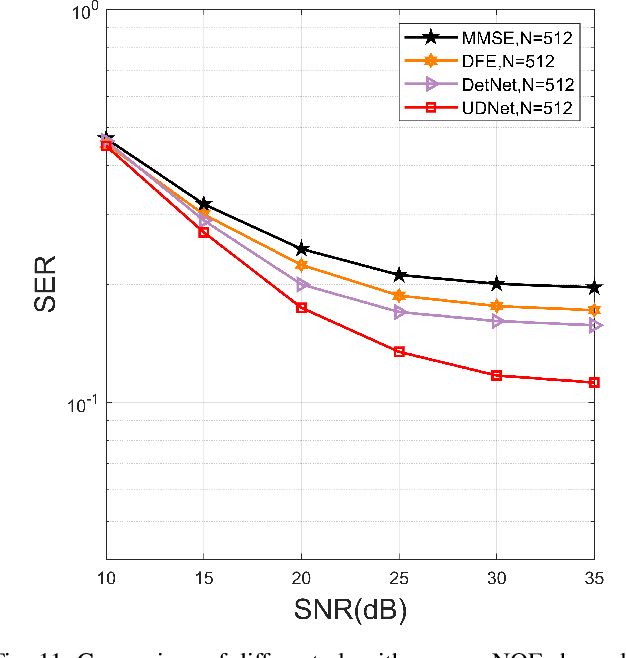

Abstract:It is a challenge to design a equalizer for complex time-frequency doubly-spread channels. In this paper, we employ the deep learning (DL) architecture by that unfolding an existing iterative algorithm to build an equalizer named underwater deep network (UDNet) for underwater acoustic (UWA) orthogonal frequency division multiplexing (OFDM) signal. Considering constellation recognition is a classification issue, the one-hot coding and softmax layer are adopted in the proposed network to achieve the minimum Kullback-Leibler (KL) criterion. Simultaneously, we introduce a sliding structure based on the banded approximation of the channel matrix to reduce computational complexity and aid UDNet performs well for different length signals without changing the network structure. Furthermore, we apply the environment of the true UWA channel as much as possible, including utilize measured doubly-spread UWA channel and offshore background noise to evaluate the UDNet. Experimental results show that in the case of 10-35dB SNR, UDNet achieves better performance with low computational complexity.
Detection Interval for Diffusion Molecular Communication: How Long is Enough?
Apr 19, 2022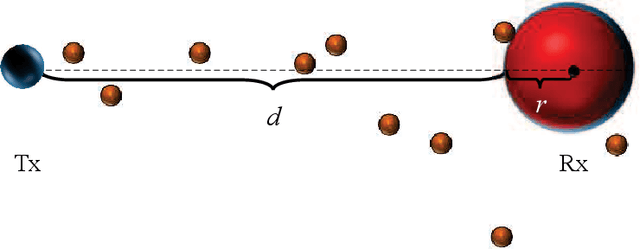
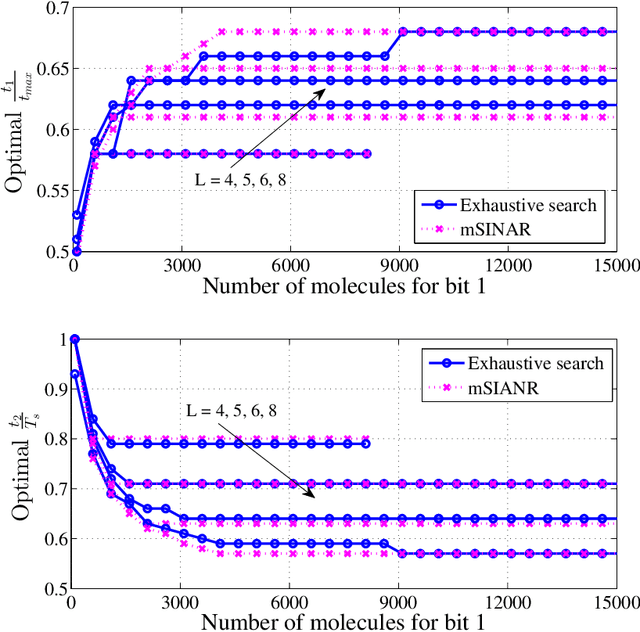
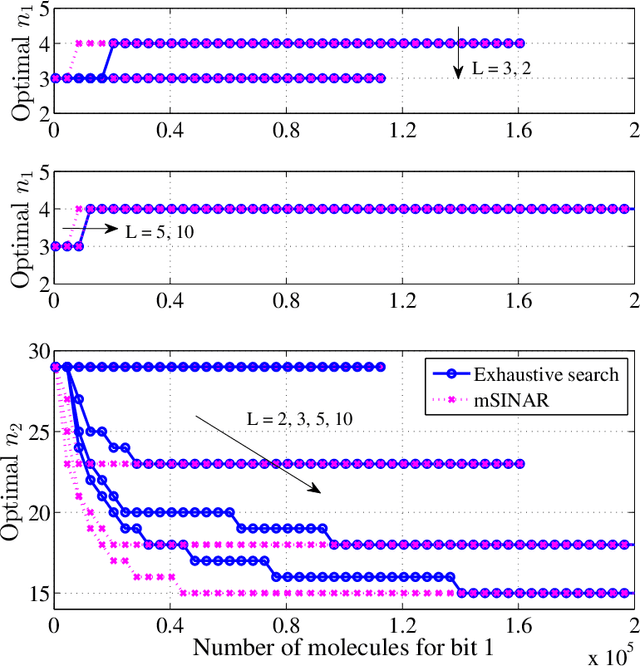
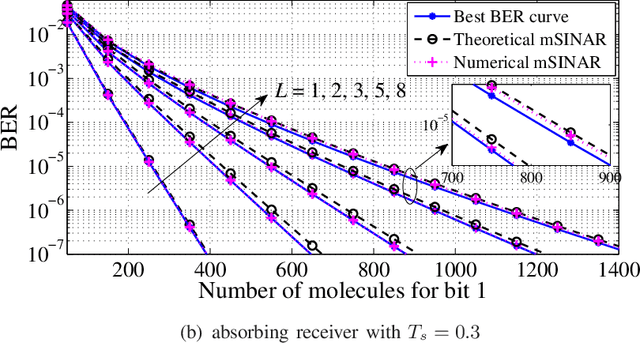
Abstract:Molecular communication has a key role to play in future medical applications, including detecting, analyzing, and addressing infectious disease outbreaks. Overcoming inter-symbol interference (ISI) is one of the key challenges in the design of molecular communication systems. In this paper, we propose to optimize the detection interval to minimize the impact of ISI while ensuring the accurate detection of the transmitted information symbol, which is suitable for the absorbing and passive receivers. For tractability, based on the signal-to-interference difference (SID) and signal-to-interference-and-noise amplitude ratio (SINAR), we propose a modified-SINAR (mSINAR) to measure the bit error rate (BER) performance for the molecular communication system with a variable detection interval. Besides, we derive the optimal detection interval in closed form. Using simulation results, we show that the BER performance of our proposed mSINAR scheme is superior to the competing schemes, and achieves similar performance to optimal intervals found by the exhaustive search.
Federated Meta Learning Enhanced Acoustic Radio Cooperative Framework for Ocean of Things Underwater Acoustic Communications
May 24, 2021



Abstract:Sixth-generation wireless communication (6G) will be an integrated architecture of "space, air, ground and sea". One of the most difficult part of this architecture is the underwater information acquisition which need to transmitt information cross the interface between water and air.In this senario, ocean of things (OoT) will play an important role, because it can serve as a hub connecting Internet of things (IoT) and Internet of underwater things (IoUT). OoT device not only can collect data through underwater methods, but also can utilize radio frequence over the air. For underwater communications, underwater acoustic communications (UWA COMMs) is the most effective way for OoT devices to exchange information, but it is always tormented by doppler shift and synchronization errors. In this paper, in order to overcome UWA tough conditions, a deep neural networks based receiver for underwater acoustic chirp communication, called C-DNN, is proposed. Moreover, to improve the performance of DL-model and solve the problem of model generalization, we also proposed a novel federated meta learning (FML) enhanced acoustic radio cooperative (ARC) framework, dubbed ARC/FML, to do transfer. Particularly, tractable expressions are derived for the convergence rate of FML in a wireless setting, accounting for effects from both scheduling ratio, local epoch and the data amount on a single node.From our analysis and simulation results, it is shown that, the proposed C-DNN can provide a better BER performance and lower complexity than classical matched filter (MF) in underwater acoustic communications scenario. The ARC/FML framework has good convergence under a variety of channels than federated learning (FL). In summary, the proposed ARC/FML for OoT is a promising scheme for information exchange across water and air.
A Splitting-Detection Joint-Decision Receiver for Ultrasonic Intra-Body Communications
Jan 05, 2021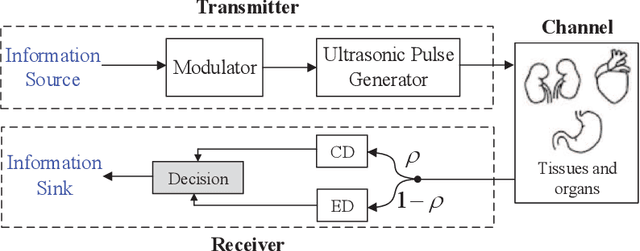
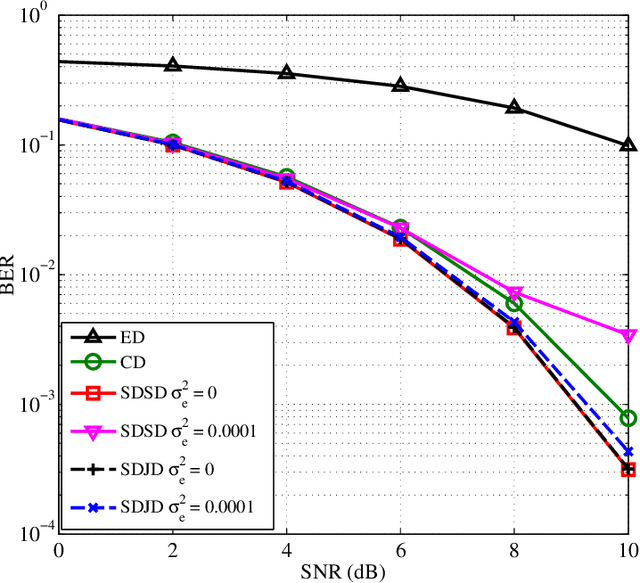

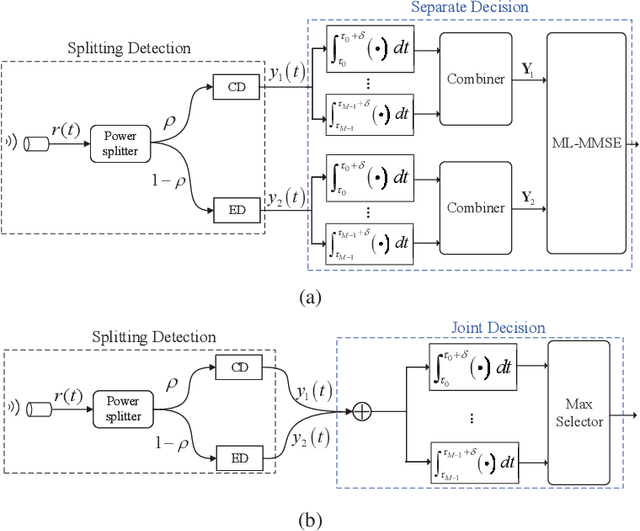
Abstract:Ultrasonic intra-body communication (IBC) is a promising enabling technology for future healthcare applications, due to low attenuation and medical safety of ultrasonic waves for the human body. A splitting receiver, referred to as the splitting-detection separate-decision (SDSD) receiver, is introduced for ultrasonic pulse-based IBCs, and SDSD can significantly improve bit-error rate (BER) performance over the traditional coherent-detection (CD) and energy detection (ED) receivers. To overcome the high complexity and improve the BER performance of SDSD, a splitting-detection joint-decision (SDJD) receiver is proposed. The core idea of SDJD is to split the received signal into two steams that can be separately processed by CD and ED, and then summed up as joint decision variables to achieve diversity combining. The theoretical channel capacity and BER of the SDSD and SDJD are derived for M-ary pulse position modulation (M-PPM) and PPM with spreading codes. The derivation takes into account the channel noise, intra-body channel fading, and channel estimation error. Simulation results verify the theoretical analysis and show that both SDSD and SDJD can achieve higher channel capacity and lower BER than the CD and ED receivers with perfect channel estimation, while SDJD can achieve the lowest BER with imperfect channel estimation.
 Add to Chrome
Add to Chrome Add to Firefox
Add to Firefox Add to Edge
Add to Edge